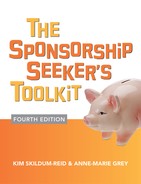CHAPTER 5
Creating a Hit List
Once you understand your target markets and what you have to offer, you should start developing a preliminary hit list of potential sponsors. In fact, you will often start thinking of companies when you go through the previous exercises.
When creating a list of potential sponsors, be sure to pay attention to specific brands, products or services, not just the overall corporation. We cannot emphasize this enough. There are three reasons for this.
1. Very few companies have only one product or brand and, where there are multiple brands, they are often very different from each other. Their differing attributes and target markets will fit with varying types of sponsorships.
2. Corporate sponsorship departments are usually the first place that sponsees go with their proposals, and hence they are inundated with requests. Going directly to a well-matched brand area can minimize the competition you will face for both attention and money. Plus, many sponsorship departments do not have the authority to make major sponsorship decisions, with sponsorship managers operating largely as gatekeepers. More and more, that authority is falling to the brand team anyway.
3. The brand areas will almost always have their own marketing budgets, and those budgets are often reasonably flexible. These areas are most closely accountable for the performance of their brands, rather than where the money is spent, and are often willing to put marketing funds that are not specifically committed to something else into sponsorship if they believe they will get a positive result.
![]()
Sponsor Matching
A good hit list will be based upon matching your event or property with a sponsor. There are three ways of doing this:
• By target markets
• By objectives
• By attributes/values
The power is where two or more of these matches intersect (Figure 5.1).
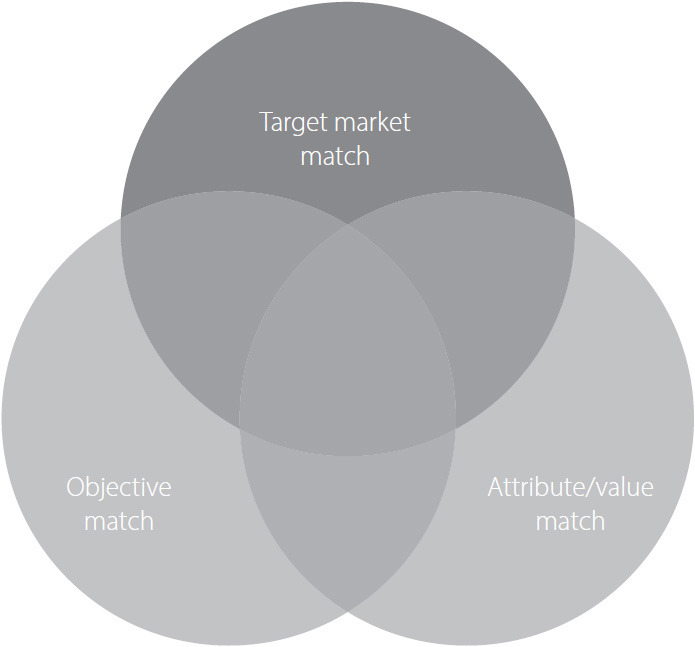
Figure 5.1 The best sponsorships are matched three ways
Audience Matching
The starting point for sponsor matching is ensuring that your event or product targets one or more of the sponsor’s core audiences. The more of your target markets that match the sponsor’s target markets, the more potential there is for a strong sponsorship. If you don’t match any of the potential sponsor’s target markets, then it does not matter how well you match objectives or attributes, you are wasting your time.
There are several types of sponsor audiences that you could match:
• Current customers
• Potential customers that fit one of the sponsor’s current customer profiles
• Newly targeted potential customer groups
• Intermediary customers (retailers, trade, distribution)
• Internal customers (sponsor employees and/or shareholders)
There is one common pitfall surrounding newly targeted customer groups. Often, sponsorship seekers will realize that their event does not target any of a company’s different markets. Instead, they try to make a case that they can deliver new markets. Although this approach is very proactive, it rarely works.
When a company targets a new group of customers, the initiative is usually developed through market research and accompanied by a comprehensive marketing campaign. If the company has not already identified your marketplace as having a potential for them, it is unlikely that they will be receptive to your approach, particularly within your time frame. In addition, one sponsorship on its own is unlikely to deliver the critical mass of people needed to make the new marketplace desirable for the potential sponsor.
Exercise
We have developed an easy way to develop your hit list based on target market matching. Starting with the “one person” descriptions from your Target Market Assessment Worksheet (Chapter 2), for each of your segments, write down any brands or categories of product/service that would feature reasonably prominently in their lives.
Aim for a big list—at least a couple of dozen brands for each target market. What you will notice is that the better and more complete your one-person description is, the easier it will be to find potential sponsors for your hit list. There will definitely be some red herrings on your hit list, but don’t be deterred. This is a brainstorming exercise and you will find some genuine prospects. Plus, you will be finding out a lot of information about these potential sponsors before approaching them. If they aren’t right for your organization or the event, it will be obvious long before you commit yourself to anything.
Attribute Matching
Strong attribute matching is one of the hallmarks of great sponsorship. It creates relevance between the sponsor and your event, which carries through, creating relevance and interest in the sponsorship to your target markets.
Look at the brand bullseye that you prepared in Chapter 2. Just as there are different levels to your organization’s personality, there are also different levels in how you can match with a potential sponsor.
• Your “soul,” in the center circle, is the core of what you are about. Matching one or more of these with a sponsor is absolutely essential in order to create an authentic match that a sponsor can use to underpin their own brand.
• Attributes, found in the “perceptions” and “hot buttons” part of your bullseye, are the areas where you can define yourself to best match a potential sponsor. This is where you can be somewhat of a chameleon, creating a strong and relevant appeal to a wide range of potential sponsors.
When identifying potential attribute matches, remember that there are two different ways of matching:
1. Attribute equals attribute. For example, a women’s contemporary art exhibition has the attributes of being smart, strong, sexy, and original. This may be a good match with Calvin Klein fragrances, which markets itself in the same way.
2. Sponsor attribute solves sponsee attribute. For example, being a member of a rally driving team has to be one of the world’s dirtiest occupations. This may be a good match for a laundry soap, car wash, personal care products, or Black and Decker’s Dustbuster.
Promoting a strong attribute match can be a big selling point. When used in an interesting or humorous way, attribute matching can lead to new approaches to creative advertising and is a great way for a company to cut through the clutter of a heavily sponsored event.
Keep in mind that who you don’t target can be just as important as who you do. Be sure you take into account the impact on your organization’s image and target market before you approach any potential sponsor.
A case in point is the National Education Association in the United States. The NEA decided against accepting sponsorship from Hyundai, as most of the teachers who make up the membership are unionized and Hyundai is not. The NEA realized that taking sponsorship from a nonunionized manufacturer would undermine its credibility with its membership and could spark a major backlash.
Vetting
At this point, it’s likely you have two big, messy lists of possible sponsors, and we find it very useful to do a quick assessment of your best candidates. How? Easy. Just look at the specific brands and specific categories of brands (e.g., “work boots,” not “shoes”) that appear on both lists. Brands that feature on both lists can be considered your A-list, and you need to look at objective matching.
Objective Matching
This type of matching does not always happen, but it can be a very powerful tool for gaining sponsorship if it does. Objective matching happens when you and your sponsor share actual objectives, such as “promoting good health and nutrition to primary school students,” or when your objectives are mutually complementary.
Extending Your Hit List
By now, you should have a nice, tight A-list of sponsors to approach in your first tranche, but you can probably extend that a bit.
Go for 2nd, 3rd, 4th . . .
Oftentimes, sponsees target only the biggest companies in a given category: The market-leading telecommunications company, the biggest airline, the biggest bank. We’re not saying that those brands might not be great sponsors, but there is a strong case for looking at their direct competitors.
They Are More Motivated to Do Something Innovative
Market leaders can tend to be conservative in their marketing approach, landing somewhere along the lines of, “If it ain’t broke, don’t fix it.” On the other hand, brands that are trying to become market leaders tend to do more interesting, innovative marketing, and best-practice sponsorship definitely qualifies.
They Get Fewer Approaches
So many sponsorship seekers make the assumption that the market leader will be the best or most cashed-up sponsor that these companies get inundated with proposals. The same can’t be said for many of their competitors. On a number of occasions, we’ve had competing sponsors in the same public workshop and asked how many approaches they get in a month, and the answers can be shocking. It’s not uncommon to hear that the market leader gets 15 to 20 times more proposals in a month, and in one instance, the market-leading telecom thought they received 6,000 to 7,000 proposals and other unsolicited requests a month, where the number two telecom got about 200.
They Move Faster
This is not a hard-and-fast rule, but if you’re approaching a company that has a culture of innovation and they receive far fewer proposals, there is likely to be less red tape and fewer hurdles for a genuinely great offer to be approved.
Get Referrals
A lot of corporate sponsors know each other, and you should use that to your advantage. If you have happy sponsors, ask them for referrals to other potential sponsors. Just use the direct approach, and ask if they know of any other sponsors that would be a good match for your organization. Some sponsors won’t be a lot of help, but others will be a wealth of information, not only about who may be interested, but what their hot buttons are and how best to approach them.
If you have any doubts as to the satisfaction level of a sponsor, don’t ask them for a referral. You will only make yourself look silly. Take some time to improve your relationship and their results before you ask.
![]()
Research Your Potential Sponsors
If you ask a sponsor, any sponsor, what they want from a sponsorship proposal, they will invariably say one thing: “We want a proposal that is tailored to our needs.” The big question is, how do you know what they need?
Now that you know how you can match with a potential sponsor, you need to get the information that will allow you to assess their suitability—do you match?—as well as allowing you to create an offer that meets their needs.
Your job as a sponsee is to assist your sponsor in meeting their needs. In order to do that, you should know your potential sponsor’s:
• Long-term marketing objectives (over 12 months)
• Short-term or tactical marketing objectives
• Product or brand attributes
• Needs—absolute requirements
• Wants—these are things that would be nice
• Exclusions—many companies, for instance, will not sponsor individuals, and some will not be involved if an alcohol company is a prime sponsor, so you need to know these things.
• Special emphases—basically everything else, such as new product launches, new services being offered, a new logo, their competitive situation
In Chapter 4, when we discussed creating an inventory of your assets, we compared the inventory to a kitchen. Well, the research you gather about your potential sponsor is your recipe.
The Sponsor Information Checklist that can be found later in this chapter will help you to compile and organize this information. Completing this checklist will provide you with a strong understanding of what a potential sponsor requires from a sponsorship investment. It should be completed in full prior to developing your offer.
As you complete the checklist for each of the companies on your preliminary hit list, you will notice that a number of potential sponsors will emerge as being very strongly matched with your event, some less so, and many companies will be excluded altogether. This process will save you a lot of time, as you will then only approach the most likely sponsors. It will also demonstrate to potential sponsors that your primary aim in sponsorship is to understand what they need to achieve and to help them achieve it.
The sources for obtaining the information for the Sponsor Information Checklist are outlined below in the order in which they should be utilized or approached.
![]()
First, Use Other Sources
Before you even bother picking up the telephone to call a company, you need to research them thoroughly through other sources. If you have a list of prospects, a couple of afternoons spent on the Internet and at the library can provide you with a lot of information.
Use this information to fill out, as completely as possible, the Sponsor Information Checklist for each of your potential sponsors.
A range of research, news, and networking resources is included in Appendix 2.
Sponsorship Guidelines
The fastest, cleanest, and usually most complete way to get the required information from a sponsor is to request a copy of their sponsorship guidelines. This is (usually) a short document that outlines all of their needs, exclusions, target markets, and the process by which they make investment decisions.
Although sponsorship guidelines are gaining popularity with sponsors, not all companies have them. If you come across one that does not, you can make yourself look great and add value to your relationship by providing our version of this valuable tool to them. Clearly, the Sponsorship Guidelines Template that we have provided later in this chapter is just an example that the sponsor will need to customize to reflect their unique needs and positioning.
Website(s)
Have a good look at their company website in your country, as well as any pages or websites devoted to the specific brand(s) you’re targeting. For instance, you could check out the Unilever’s UK website, but if you’re targeting their Dove brand, you’d also check out the Dove page on the Unilever website, as well as Dove’s stand-alone brand website.
What you’re looking for:
• Messages that indicate their brand values and attributes
• Who they appear to be targeting
• Clues as to their current priorities
• Information about their sponsorship-driven or promotional activity, which will tell you how they like to use their sponsorships
• Any brand cross-promotions: Are they cross-promoting with other brands owned by the same company? Different companies? Specific retailers?
If your target brand has headquarters or major markets overseas, do check out the global website and websites in other major markets. What you’re looking for:
• Insight as to new initiatives, products, or brand extensions that may be coming to your region
• Information on how they use sponsorship in other markets
![]()
Social Media
If you’re researching a brand, definitely “Like” the brand Facebook page and follow them on Twitter, Instagram, YouTube, and other key social media. You will get real-time insights as to what their priorities are, but you’ll also get a very strong indication of how they interact with their target markets. Is it all one-way sales messaging, or do they interact on a more human level? Do they run contests? Ask for fans to create content or give suggestions? All of this will give you a strong feeling for the tone, innovation, and responsiveness of their marketing activities.
Television Ad Aggregators
There are dozens of websites around the world that collect television ads for your viewing pleasure. A quick way to get an understanding of a brand that you may not be personally familiar with is to do an Internet search on “[brand] television ads [your country/region]”. Check out the most recent ads, which should give you some insight as to what they’re focusing on, their target markets (who they’re talking to), and their key messages.
![]()
ABI/Inform Full-Text Online
This is an essential (and free) resource for people in this industry and a must-have for sponsorship seekers. You can enter keywords—search engine style—and it will search thousands of business publications around the world and bring you back the whole articles relating to that topic. You can mark the ones that are interesting to you and email them to yourself. The kinds of things you will find are
• Background on how sponsors you’re targeting use their sponsorship investments
• Background on what multinational sponsors do in other countries
• Background on how sponsors use their sponsorships of properties like yours around the world
• Examples of best-practice sponsorship—win-win-win!
• Examples of interesting, out-of-the-box sponsorships
• Examples of interesting, out-of-the-box sponsorship benefits
• Precedent to add weight to that great sponsorship idea you have
The kicker is that mostly only university and major public libraries have a license to this. The good news is that you should be able to get a library card and PIN number to remotely log into the online materials from your office. Just call and ask your closest major library about the process to get a card and PIN number because you want to access ProQuest databases. (ABI/Inform is a ProQuest service.)
Annual Report
When we wrote the first edition of this book, reviewing a company’s annual report was considered an essential part of understanding their organizational and brand culture. With the prevalence of information available online, it has faded in relevance.
That said, you may find it useful to download an online copy of the most recent financial report, as it could give you some or all of the following:
• An understanding of the corporate mission and vision
• A list of all products and brand lines
• The overall financial performance of the company (and often specific product categories)
• Annual expenditure on sponsorship
• A list of all (or sometimes only major) sponsorships
• New company initiatives
• Income and expenditure trends
. . . Then Talk to the Sponsor
By this time, you should have your Sponsor Information Checklist about 80 percent completed and should be prepared to speak to the sponsor to fine-tune your understanding of their goals and markets.
In-Person Meetings
No matter how much information you find about a company from other sources, it is always ideal to meet with a potential sponsor prior to developing a proposal. There are several reasons for this:
• You will gain a lot more insight from a conversation than from even the best proposal guidelines.
• You will develop a personal relationship with the brand or sponsorship manager.
• Your enthusiasm and belief in the project will often be infectious.
• It is more difficult for someone to brush you off if you are sitting there in person.
Be sure to do your homework before your in-person meeting. Again, you should endeavor to fill out as much as possible of your Sponsor Information Checklist before making contact. This will allow you to demonstrate your professionalism and commitment to understanding their needs. You can also use what you know about the company and its sponsorship program to find out what has and has not worked for them in the past, how sponsorships were utilized, and other pertinent pieces of information.
Example
Instead of . . .
“What are your top five marketing objectives?”
Say . . .
“You seem to be targeting an increasingly younger, cooler marketplace. Is that reflective of where your brand is going, or are you simply extending your existing markets to include them?”
![]()
Or . . .
“In my research, I noticed that the brand is extending into premium ice cream flavors in America. Is that something that’s likely to happen in Canada? Any idea on time frame, as we may be able to assist with your launch activities?”
What you absolutely don’t want to do is go straight into a sales pitch. You need to ask great questions and understand their needs before you’re ready to sell to that sponsor. Keep any sales rhetoric right out of your conversation during this meeting. Your goal is to understand their needs and showcase that you’re different from the sponsorship sales people they usually meet, and someone they want to work with. If you can do that, they’ll invite a proposal from you.
For specific meeting techniques, see the Sales Checklist in Chapter 7.
Telephone Interview
If you cannot have a meeting in person with the potential sponsor, a telephone interview is definitely the next best thing. Again, it is imperative to do your homework prior to picking up the telephone, or you could do more harm than good.
Do make an appointment for the interview, just as if you were there in person, and stick to your allotted time.
What If You Can’t Reach the Sponsor?
Brand managers are busy and can be hard to reach—though they are usually easier to reach than sponsorship managers. In any case, if you can’t reach the brand manager and are confident that the sponsorship is a good match for them, you can use all that you have researched about a sponsor to create a customized proposal without their input.
Do note, this is your fallback position and not ideal. Don’t make this your primary strategy just because you’re nervous about making the call or going to the meeting. Doing that hard stuff is as much a part of your job as the rest of this, so take a deep breath and pick up the phone.
 Sponsor Information Checklist
Sponsor Information Checklist
The idea of the Sponsor Information Checklist is to provide you with a format so that you can obtain as much information about your target sponsor as you possibly can, by giving you all of the clues you need to make your best shot at gaining their sponsorship. Do not worry if you cannot get all of the information, but do try to get most of it before creating your offer.
If you speak to your potential sponsor, be reasonable about the amount of information you request and the time you need to gather this information. Know the basics and ask about objectives, target markets, and new initiatives first. Also, get the correct address, name, and title from the receptionist or assistant, not from your target contact.
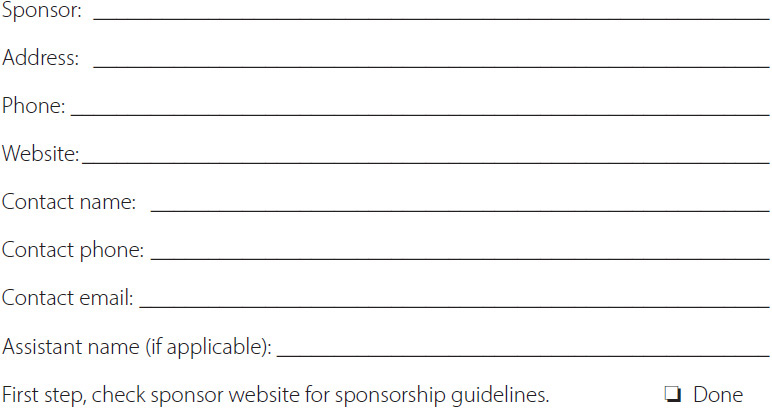
Key Brand/Product Attributes

Objectives
What perceptions are they trying to change about this brand? What behaviors?

Relevant Product Lines and Target Markets
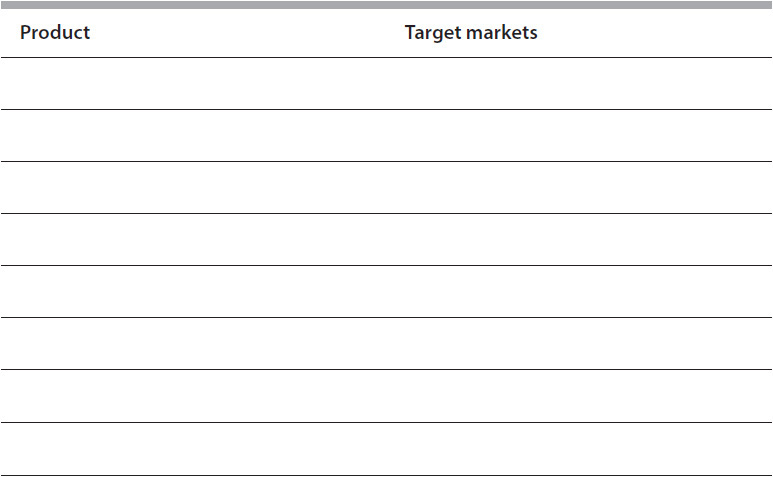
New Initiatives
Have they recently or are they planning to add to or extend their brand lines, change their logo, relaunch a product, merge with another company, or enter into a new or distinctive marketing campaign? Please describe.
![]()
![]()
![]()
Key Direct Competitors in Their Category

Key Indirect Competitors
(Other categories that may compete with their category)

How Do They Utilize Their Sponsorships?
![]()
![]()
Precedent
Has this company ever sponsored a similar property? Can you get any information on how that went? (Speak to the other sponsee if you feel it is appropriate.)
![]()
![]()
Is there any national or overseas precedent for a relationship such as this? Do you have a copy of any supporting magazine or newspaper articles?
![]()
Exclusions
Do they have any exclusions in the area of sponsorship?
![]()
Approvals
How long should approval take, and what is the approval procedure for sponsorship?
![]()
Date: ![]()
Information gathered by: ![]()
 Sponsorship Guidelines Template
Sponsorship Guidelines Template
Hawk Brewing receives dozens of proposals every year, many of which we reject because they do not adequately meet our needs. We have developed this document to make our requirements clear to potential sponsorship seekers and to encourage the presentation of proposals that meet those needs.
General
• We will consider proposals in all categories except [insert exclusions here].
• We require sponsorship and sales (if applicable) exclusivity in the category of beer and premixed alcoholic beverages.
• We generally need a minimum of six months lead time to effectively plan and implement our leverage activities.
• Logo and/or name exposure is considered a bonus but is not the primary goal of sponsorship.
• We prefer to invest in sponsorships that carry out audience research during and/or after the event, including questions relating to our industry, and provide results to Hawk Brewing.
• We expect that our sponsorship partners will invest a minimum of 10 percent of the total value of the sponsorship to proactively add value to the sponsorship.
[Sponsor] Brand Positioning
Here is a short overview to assist you in understanding our brand positioning. Our goal is to partner with organizations and events that are a strong, natural match to at least some aspects of our brand positioning. For example,
• Not everyone can be a Hawk” (tag line)
• Premium beers (including brands for true beer connoisseurs)
• Smart, witty, irreverent
• Cool, sexy
• An American status product
• “Drink Responsibly” message
As we expand overseas, our goal is to become known as an American status brand that retains its desirability independent of any prevailing or cultural attitudes toward America (think “Levi’s”).
Target Markets by Product
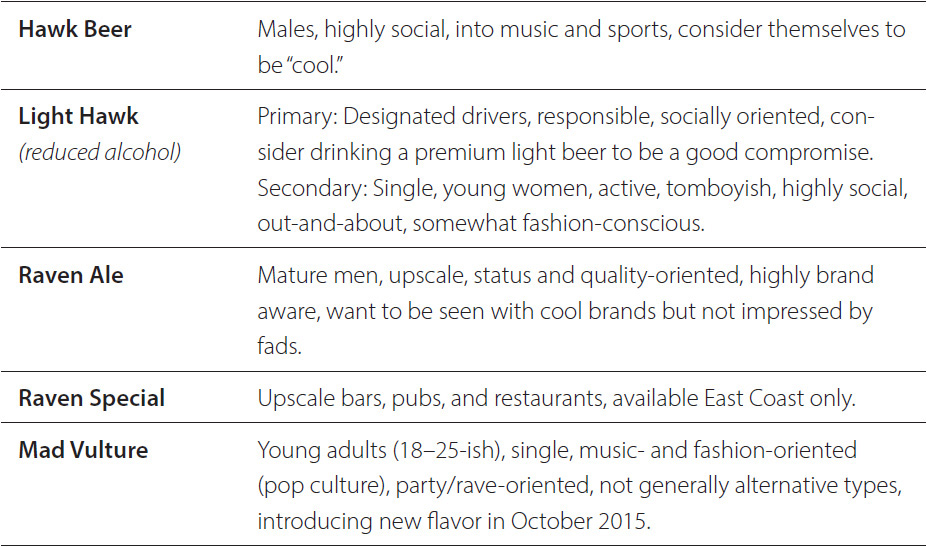
Sponsorships must provide at least six of the following:
[These should be tied to both your overall objectives and key attributes/values and should number 10 to 15.]
• A natural link with our brand positioning (see above)
• Provision of exclusive and meaningful content for our website, social media, app development, etc.
• Onsite sales
• Exclusive event, access, or area for members of Hawk’s Hawkeye Club (1.2 million members worldwide, 84 percent in North America)
• Provide opportunity for key customer hospitality (“what money cannot buy” activities are particularly good)
• Opportunities to host pre- or post-event parties, concerts, or other over-21 social activities
• Celebrity appearances at key pubs and clubs (or “virtual” appearances in video web chats or webcasts)
• Other event-related benefits that we can pass along to a large proportion of our customer base (both consumers and trade). Feel free to use your imagination.
• Product placement (using one or more of our brands in a meaningful way as part of the event)
• Ticket discounts, premium tickets, or access to an exclusive ticket line for customers with proof-of-purchase
• Ability for Hawk Brewing staff to participate in a meaningful way
To be considered, proposals must include
• Key details of the opportunity
• Overview of your marketing plan, including what is and is not confirmed
• List of sponsors who have committed to date
• Comprehensive list of benefits, including how they relate to us and our products
• Creative ideas as to how we can use this sponsorship and those benefits to connect with our target markets
• Timeline, including important deadlines
• Credentials of your company and key subcontractors (publicist, event producer, etc.)
Process for Consideration:
• All proposals are reviewed by Sponsorship Manager to assess suitability, feasibility, and resources required (human and monetary)
• Recommended proposals are presented to [insert title] for approval
• Sponsee is notified of the disposition of the proposal within [X] weeks.
Submit Proposal to:
[Insert full contact details]
